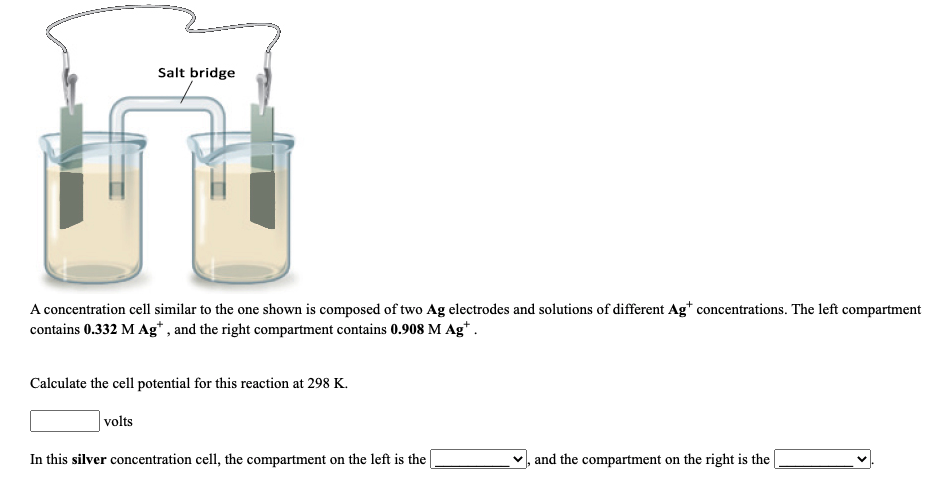A concentration cell similar to the one shown is composed of two Ag electrodes and solutions of different Ag+ concentrations. The left compartment contains 0.332 M Ag+ , and the right compartment contains 0.908 M Ag+ . Calculate the cell potential for this reaction at 298 K. volts In this silver concentration cell, the compartment on the left is the , and the compartment on the right is the .
A concentration cell similar to the one shown is composed of two Ag electrodes and solutions of different Ag+ concentrations. The left compartment contains 0.332 M Ag+ , and the right compartment contains 0.908 M Ag+ . Calculate the cell potential for this reaction at 298 K. volts In this silver concentration cell, the compartment on the left is the , and the compartment on the right is the .
Chemistry: Principles and Reactions
8th Edition
ISBN:9781305079373
Author:William L. Masterton, Cecile N. Hurley
Publisher:William L. Masterton, Cecile N. Hurley
Chapter21: Chemistry Of The Nonmetals
Section: Chapter Questions
Problem 61QAP: Consider the reduction of nitrate ion in acidic solution to nitrogen oxide (Ered=0.964V) by sulfur...
Related questions
Question
A concentration cell similar to the one shown is composed of two Ag electrodes and solutions of different Ag+ concentrations. The left compartment contains 0.332 M Ag+ , and the right compartment contains 0.908 M Ag+ .
Calculate the cell potential for this reaction at 298 K.
volts
In this silver concentration cell, the compartment on the left is the , and the compartment on the right is the .

Transcribed Image Text:Salt bridge
A concentration cell similar to the one shown is composed of two Ag electrodes and solutions of different Ag* concentrations. The left compartment
contains 0.332 M Ag*, and the right compartment contains 0.908 M Ag*.
Calculate the cell potential for this reaction at 298 K.
volts
In this silver concentration cell, the compartment on the left is the
v, and the compartment on the right is the
Expert Solution
This question has been solved!
Explore an expertly crafted, step-by-step solution for a thorough understanding of key concepts.
This is a popular solution!
Trending now
This is a popular solution!
Step by step
Solved in 3 steps with 3 images

Knowledge Booster
Learn more about
Need a deep-dive on the concept behind this application? Look no further. Learn more about this topic, chemistry and related others by exploring similar questions and additional content below.Recommended textbooks for you

Chemistry: Principles and Reactions
Chemistry
ISBN:
9781305079373
Author:
William L. Masterton, Cecile N. Hurley
Publisher:
Cengage Learning


Principles of Modern Chemistry
Chemistry
ISBN:
9781305079113
Author:
David W. Oxtoby, H. Pat Gillis, Laurie J. Butler
Publisher:
Cengage Learning

Chemistry: Principles and Reactions
Chemistry
ISBN:
9781305079373
Author:
William L. Masterton, Cecile N. Hurley
Publisher:
Cengage Learning


Principles of Modern Chemistry
Chemistry
ISBN:
9781305079113
Author:
David W. Oxtoby, H. Pat Gillis, Laurie J. Butler
Publisher:
Cengage Learning

Chemical Principles in the Laboratory
Chemistry
ISBN:
9781305264434
Author:
Emil Slowinski, Wayne C. Wolsey, Robert Rossi
Publisher:
Brooks Cole

Chemistry
Chemistry
ISBN:
9781305957404
Author:
Steven S. Zumdahl, Susan A. Zumdahl, Donald J. DeCoste
Publisher:
Cengage Learning

Chemistry: An Atoms First Approach
Chemistry
ISBN:
9781305079243
Author:
Steven S. Zumdahl, Susan A. Zumdahl
Publisher:
Cengage Learning